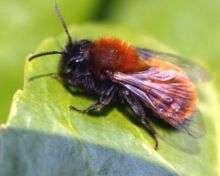Tawny mining bee
| Tawny mining bee | |
|---|---|
 | |
| Scientific classification | |
| Kingdom: | Animalia |
| Phylum: | Euarthropoda |
| Class: | Insecta |
| Order: | Hymenoptera |
| Family: | Andrenidae |
| Genus: | Andrena |
| Species: | A. fulva |
| Binomial name | |
| Andrena fulva Müller, 1766 | |
The tawny mining bee, Andrena fulva, is a European species of the sand bee (Andrena) genus. The males are 10–12 mm (0.4–0.5 in) and the females 8–10 mm (0.3–0.4 in) long. It is covered with hair: fox-red on its back and black on its underside.
The tawny mining bee lives in Europe, ranging from the Balkans to southern Scandinavia, the United Kingdom and Ireland.[1] It lives in light woodlands and dry grasslands, and also in parks and gardens. It is widely distributed but has a low population density. The Tawny mining bee flies from March until May. It prefers to fly in a multitude to different nectar-bearing plants. It lives in a nest in the ground, and occasionally in larger colonies.
It mates in spring, after which the male dies and the female starts to build a nest. Sometimes more than a hundred females build nests in a few square metres but the tawny mining bee normally does not create a colony: each female has her own nest. The tawny mining bee is therefore classified amongst solitary and communal bees.
The nest is a vertical shaft 200–300 mm (8–12 in), with several brood cells branching off it. The female fills these cells with a mixture of nectar and pollen, on which she lays one egg in each cell. The larva hatches within a few days, grows quickly and pupates within a few weeks. The adults emerge in spring after hibernation.
References
- ↑ Shevaun Doherty Botanical Artist. paying tribute to the hardest working insects on the planet. [An Post. 16 July 2018. Retrieved 17 July 2018 – via facebook.com.